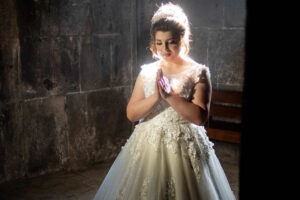Gowns are typically created through a combination of design, pattern making, fabric selection, cutting, sewing, fitting, and embellishing. Here are the general high level steps involved in creating a gown:
- Design: The first step in creating a gown is to create a design. This can be done by sketching the design on paper or by using a computer-aided design (CAD) program. The designer will consider factors such as the occasion, the wearer’s body shape, and any trends or preferences to create a unique and visually appealing design.
- Fabric selection: Once the design is finalized, the next step is to select the fabric. Gowns can be made from a wide range of fabrics, including silk, satin, chiffon, lace, and tulle. The fabric choice will depend on the design, the wearer’s preferences, and the occasion.
- Pattern making: After the fabric is selected, a pattern is created based on the design. This involves creating a blueprint or template of the gown, including measurements and details such as darts, pleats, and gathers. The pattern is typically made using specialized software or by hand.
- Cutting the fabric: Once the pattern is created, the fabric is cut according to the pattern pieces. This is typically done using a cutting table and a rotary cutter or fabric scissors. It is important to cut the fabric carefully to ensure that the pieces fit together properly.
- Sewing: The cut pieces of fabric are then sewn together using a sewing machine or by hand. This involves stitching the seams, hems, and any other details such as sleeves or bodices. The sewing process can be time-consuming, especially for complex designs.
- Fitting: Once the gown is sewn together, a fitting is done to ensure that the gown fits the wearer correctly. Adjustments are made as necessary, and the gown is then altered or finished accordingly. Multiple fittings may be required to ensure a perfect fit.
- Embellishments: Depending on the design, embellishments such as beads, sequins, embroidery, or appliques may be added to the gown. These can be sewn on by hand or with a machine. Embellishments can add texture, sparkle, and visual interest to the gown.
- Final touches: Once all the details are complete, the gown is given final touches such as pressing or steaming to ensure it looks its best. The gown is then ready to be worn for a special occasion.
Overall, creating a gown requires skill, creativity, and attention to detail. Each step in the process is important to ensure that the gown fits the wearer perfectly, looks beautiful, and is comfortable to wear. With careful planning and execution, a gown can be a stunning and unique piece of clothing that can be cherished for years to come.





